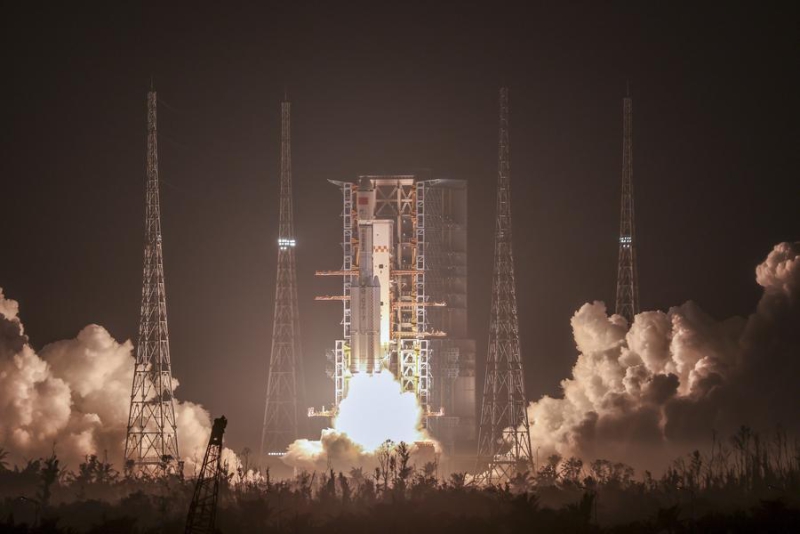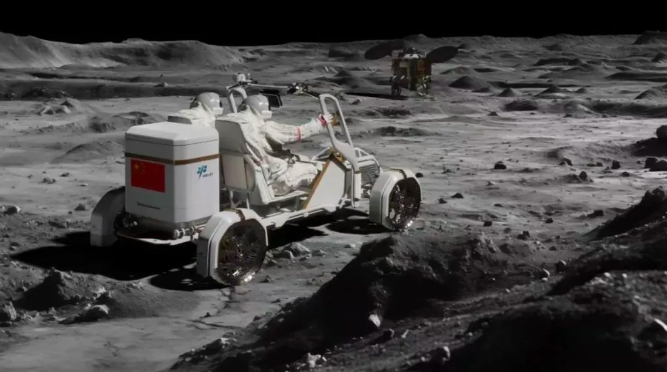China launches Tianzhou-8 cargo craft to send space station supplies


A Long March-7 Y9 carrier rocket carrying cargo spacecraft Tianzhou-8 blasts off from the Wenchang Spacecraft Launch Site in south China's Hainan Province, Nov. 15, 2024. (Xinhua/Zhang Liyun)
WENCHANG, Hainan, (Xinhua) -- China launched the cargo craft Tianzhou-8 on Friday night to deliver supplies for its orbiting Tiangong space station, according to the China Manned Space Agency.
The Long March-7 rocket, carrying Tianzhou-8, blasted off at 11:13 p.m. (Beijing Time) from the Wenchang Spacecraft Launch Site in the southern island province of Hainan, the agency said.
After about 10 minutes, Tianzhou-8 separated from the rocket and entered its designated orbit. Its solar panels soon unfolded. The agency declared the launch a complete success.
It is expected to autonomously rendezvous and dock with the rear port of the space station's core module Tianhe in about three hours after the launch.
China's Tianzhou (Sky Ship) cargo craft has a length of 10.6 meters and a maximum diameter of 3.35 meters. It consists of a cargo module and a propellant module, and is mainly tasked with transporting supplies and fuel to China's space station and bringing the waste from the space station back to the atmosphere for burning and disposing.
Tianzhou-8 is loaded with essential supplies for the orbiting crew, including living necessities, medical supplies and support materials for their spacewalks.
The supplies aboard the cargo craft are primarily intended to support the Shenzhou-19 taikonauts and the future Shenzhou-20 crew.
Tianzhou-8 also carries multiple new test payloads, which will provide crucial support for the advancement and application of new technologies, and the progress of space science.

This image is a conceptual illustration of the prototype of a Chinese manned lunar rover. (China Academy of Space Technology/Handout via Xinhua)
Notably, the "lunar soil brick," created by Chinese scientists to simulate the composition of lunar soil, is being taken aboard Tianzhou-8 for space exposure experiments.
The aim of the experiments is to confirm whether the "brick" can be used to construct houses on the moon. The first "brick" is scheduled to return to Earth by the end of 2025 after the space experiment.
There is also a unique species -- fruit flies -- among the scientific experiment payloads carried by Tianzhou-8. They are expected to help complete the country's first space sub-magnetic-microgravity composite environment science experiment.
Apart from necessities, gift packages for major Chinese holidays such as Spring Festival, Mid-Autumn Festival and Dragon Boat Festival are also included in the cargo craft, as well as birthday packages for the taikonauts.
Tianzhou-8 boasts the world's largest cargo transport capacity and the most comprehensive in-orbit support capability among all cargo craft currently in use.
The loading space of both Tianzhou-6 and Tianzhou-7, which were launched earlier, have already been increased by 24 percent compared to their predecessors. Building upon this improvement, the research team further increased the loading capacity of Tianzhou-8 by over 100 kilograms, allowing for a wider variety of goods to be carried.

This image captured at Beijing Aerospace Control Center on Oct. 30, 2024 shows the crew of Shenzhou-19 manned spaceship. (Photo by Han Qiyang/Xinhua)
Long March-7 is the country's new-generation medium-lift launch vehicle featuring high reliability, high safety and zero pollution. It has a low Earth orbit payload capacity of 14 tonnes, and can meet the requirements for sending the cargo craft into orbit precisely to allow it to dock with the orbiting space station.
This is the first launch mission at Wenchang since Super Typhoon Yagi. Prior to the launch, the Long March-7 team conducted comprehensive testing and verification stringently to guarantee safety.
Starting with this mission, there will be a spare Long March-7 rocket on standby for each space station cargo craft launch. If necessary, the spare rocket can complete another launch within three months to ensure the normal operation of the space station.
Friday's launch is the third cargo delivery mission since China's manned space program entered the space station's application and development stage. It is also the 546th mission of the Long March rocket series.

Office of the Hainan Free Trade Port Working CommitteeNo. 69 Guoxing Avenue, Meilan District, Haikou City, Hainan Province, 570203, China

hnshgb_xchch@sina.com
Contact Us
- Latest News
- Video News
- Specials
- Press Release
- Upcoming Events
What's New in Hainan
- Industrial Park
- Tax
- Trade
- Investment
- Entry & Exit
- Finance
Invest in Hainan
- Weather
- Transportation
- Health Care
- Attractions & Food
- Fitness & Sports
- Arts & Culture
Live in Hainan
- Copyright © 2020 Hainan Free Trade Port
- Qiong ICP 19005356
- All Rights Reserved





